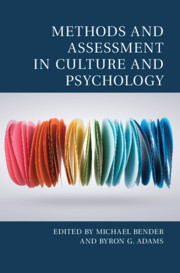Book contents
- Methods and Assessment in Culture and Psychology
- Culture and Psychology
- Methods and Assessment in Culture and Psychology
- Copyright page
- Dedication
- Additional material
- Contents
- Figures
- Tables
- Contributors
- Foreword
- 1 Introduction to Methods and Assessment in Culture and Psychology
- Part 1 Acculturation and Identity
- Part 2 Individual Differences across Cultures
- Part 3 Culture and Assessment
- Index
- References
Part 2 - Individual Differences across Cultures
Published online by Cambridge University Press: 21 January 2021
- Methods and Assessment in Culture and Psychology
- Culture and Psychology
- Methods and Assessment in Culture and Psychology
- Copyright page
- Dedication
- Additional material
- Contents
- Figures
- Tables
- Contributors
- Foreword
- 1 Introduction to Methods and Assessment in Culture and Psychology
- Part 1 Acculturation and Identity
- Part 2 Individual Differences across Cultures
- Part 3 Culture and Assessment
- Index
- References
Summary

- Type
- Chapter
- Information
- Methods and Assessment in Culture and Psychology , pp. 101 - 252Publisher: Cambridge University PressPrint publication year: 2021



